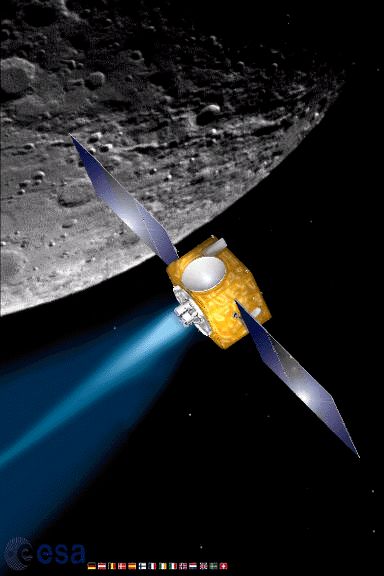Spacecraft to Slam into the Moon

Scientistsare plotting out a "crash course" in learning what happens when a Europeanlunar probe slams into the Moon.
TheEuropean Space Agency's (ESA) SMART-1 spacecraft--now circling the Moon--isheaded for a planned early September impact with Earth's celestial neighbor.
TheESA probe would plow into the lunar surface, giving it a glancing blow as itspeeds in at nearly 5,000 miles per hour (2 kilometers per second).
SMART-1is Europe's first robotic lunar mission. The name SMART stands for SmallMission for Advanced Research in Technology
Thespacecraft was launched on September 27, 2003. Making use of its ion-propulsionengine to slowly nudge it outward from Earth, the probe powered its way intolunar orbit on November 15, 2004.
Outfittedwith miniaturized instruments, SMART-1's goal has been to gauge key chemicalelements in the lunar surface, as well as look into the theory that the Moonwas formed following the violent collision of a smaller planet with Earth longago.
ESA'slunar probe completes a loop around the Moon every five hours--but that'sabout to end later this year.
Breaking space news, the latest updates on rocket launches, skywatching events and more!
Rehearsal mode
Engineersand scientists are now targeting SMART-1 for possible impact on theMoon around September 1-2. The current uncertainty range for the exacttime of impact is 15 hours.
Atthe end of June, SMART-1 is slated to carry out two maneuvers. These will fine-tunethe exact time of impact. Those slight thrust firings will lead to thespacecraft flying over the Moon at its lowest point at below186 miles (300kilometers) in altitude.
Inearly July, the plan calls for assessing the success of the maneuver anddetermining the spacecraft's orbit and expected impact time. Later that month,the probe will zip as close as 124 miles (200 kilometers) from the barren lunarlandscape.
Inearly August, SMART-1 will make an overflight of its eventual impact site,racing over that area at just 75 miles (120 kilometers) height in what's termedas "rehearsal" mode for the early September run-in with the Moon.
Accordingto Bernard Foing, ESA SMART-1 project scientist, an inventory is being made ofthe composition and mechanical properties of the spacecraft--includingaluminum, copper, titanium, and other materials, as well as the probe's remaininghydrazine fuel.
Thatdata will be used to support observations of what is kicked up from the Moonitself on impact, contrasted to bits, pieces, and fuel tossed into the mix dueto SMART-1's high-speed slap.
Boom and bust finale
Hereon Earth, sky watchers worldwide are getting ready for the projected September1-2 lunar boom and bust finale of SMART-1.
Foingtold SPACE.com that he is now engaged in assembling a "coordinatedcampaign" of ground-based observations. This activity would support SMART-1measurements and monitor the artificial crash that mimics in a small way, anasteroid or comet hit on the Moon.
Numbersof observatories around the world have indicated interest in watching theoutcome from SMART-1's collision with the Moon, Foing has reported.
At impact, the ESA spacecraft will weigh alittle over 628 pounds (285 kilograms), punching the Moon at a grazingincidence near 37 degrees south latitude. The near-side impact is timed so thatit will be illuminated to assist in observations from Earth.
Acurrent orbit simulation of the SMART-1 impact for September 2 is at lunarlongitude 44.54 degrees West and 36.22 South in Lacus Excellentiae, 10 degrees southof Mare Humorum. A far more refined target point will come as the event draws closer.
Crater-making crash
Backon July 31, 1999, the Moon was on the receiving end of NASA's Lunar Prospector.
Thatfarewell fall of space hardware struck within a crater near the lunar southpole--in an attempt to detect water ice stirred up by the wallop. No visibledebris plume was reported.
Accordingto Foing, the hope is that those Earth-based observers intending to take part inSeptember's thump of the Moon can make pre-hit predictions of SMART-1's impactmagnitude, cloud ejecta dynamics, exospheric effects and other observablemanifestations brought about by the crash.
Coordinatedmeasurements by observers here on Earth are high on the priority list, Foingnoted. Impact observations would include: Infrared imaging of thermal flash;visible/infrared imaging of ejected clouds; hydrazine flame detection;post-characterization of ejecta; as well as exospheric effects if lunarmaterial is blasted high off the Moon's surface.
Inaddition, Foing said, there is also intent to conduct follow up searches forthe crater produced by SMART-1's crash into the Moon via the sensor eyes of future,follow-on lunar orbiters.
- At the Moon Again! SMART-1 Returns First Close-Ups
- Moon Image Gallery and Viewing Guide
- SMART-1's Ion Drive: From Fiction to Fact
- SMART Science: Europeans Prepare for First Mission to the Moon

Leonard David is an award-winning space journalist who has been reporting on space activities for more than 50 years. Currently writing as Space.com's Space Insider Columnist among his other projects, Leonard has authored numerous books on space exploration, Mars missions and more, with his latest being "Moon Rush: The New Space Race" published in 2019 by National Geographic. He also wrote "Mars: Our Future on the Red Planet" released in 2016 by National Geographic. Leonard has served as a correspondent for SpaceNews, Scientific American and Aerospace America for the AIAA. He has received many awards, including the first Ordway Award for Sustained Excellence in Spaceflight History in 2015 at the AAS Wernher von Braun Memorial Symposium. You can find out Leonard's latest project at his website and on Twitter.
